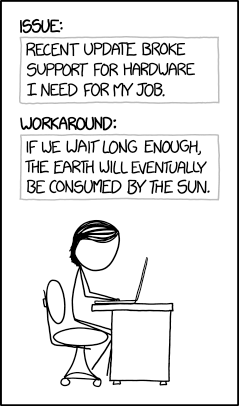
Twenty-plus years in IT have led me to believe that there are very few absolutes when it comes to software systems. Two that do seem to hold true are these:
- Creating systems is esteemed far more highly than maintaining systems.
- Systems that are not maintained, will decay.
There are a variety of reasons for this situation, many of which are baked into the architecture of the enterprise. Regardless of the why, however, the two facts remain. Without a response to those issues, entropy is inevitable.
Over the past few days, I’ve seen several blog posts by two different authors dealing with this situation in two different ways:
- Jason Gorman posted “IT’s Original Sin: Separating Authority & Expertise” Saturday and followed up with “Do It Anyway” yesterday.
- John Cutler posted “Learned Helplessness and the Ops Death-Spiral” Sunday.
Jason complains about the non-technical “leadership class” in his first post:
And hence we get someone making the big decisions about healthcare who knows nothing about medicine or about running hospitals or ambulance services. And we get someone in charge of all the schools who knows nothing about teaching or running a school. And we get someone in charge of a major software company whose last job was being in charge of a soft drinks company. And so on.
Again, this is fine, if they leave the technical decisions to the technical experts. And that’s where it all falls down, of course. They don’t.
The guy in charge of the NHS insists on telling doctors and nurses how they should do their jobs. The woman in charge of UK schools insists on overriding the expertise of teachers. The guy in charge of a major software company refuses to listen to the engineers about the need for automated testing. And so on.
This is the Dunning-Kruger effect writ large. CEOs and government ministers are brimming with the overconfidence of someone who doesn’t know that they don’t know.
In his second post he follows up with how to respond:
My pithy – but entirely serious – advice in that situation is Do It AnywayTM.
There are, of course, obligations implied when we Do It AnywayTM. What we’re doing must be in the best interests of stakeholders. Do It AnywayTM is not a Get Out Jail Free card for any decision you might want to justify. We are making informed decisions on their behalf. And then doing what needs to be done. Y’know. Like professionals.
I disagree. Strenuously.
If you go to the doctor and they tells you that you will need surgery at some point for some condition, would you expect to be forcibly admitted and operated on immediately?
If you were charged with a crime, would you expect your attorney to accept a plea bargain on your behalf without consultation or prior permission?
If neither of those professionals would usurp the right of their client/patient to make their own informed decision, why should we? Both of those examples would be considered malpractice and the first would be criminal assault in addition. Therefore, I disagree that acting on someone’s behalf without their knowledge or consent is a viable option.
John’s approach, rejecting helplessness and confronting the issues by communicating the costs (with justifications/evidence) is, in my opinion, the truly professional approach. We have a responsibility to make the problem visible and continue making it visible. We also have a responsibility to operate within the limits we’re given. We know far more about our area than someone higher up the management chain, but, that does not equate to knowing more in general than those higher up the management chain. Ignorance is relative. Micro-managing, getting deeper in the weeds than you need to is ineffective. If, however, you’re in the weeds, do you have the information necessary to say that the issue being “interfered with” is one without higher-level consequences? Dunning-Kruger can cut a wide swathe. Trust needs to cut both ways.
Imagine riding as a passenger in a car. You see the car drifting closer and closer to the shoulder. Do you point it out to the driver or do you just grab the wheel? You might prevent an accident or you just might cause one by steering into a vehicle coming up from behind that you didn’t see from your vantage point.
[Plymouth Savoy photo by Christopher Ziemnowicz via Wikimedia Commons]




